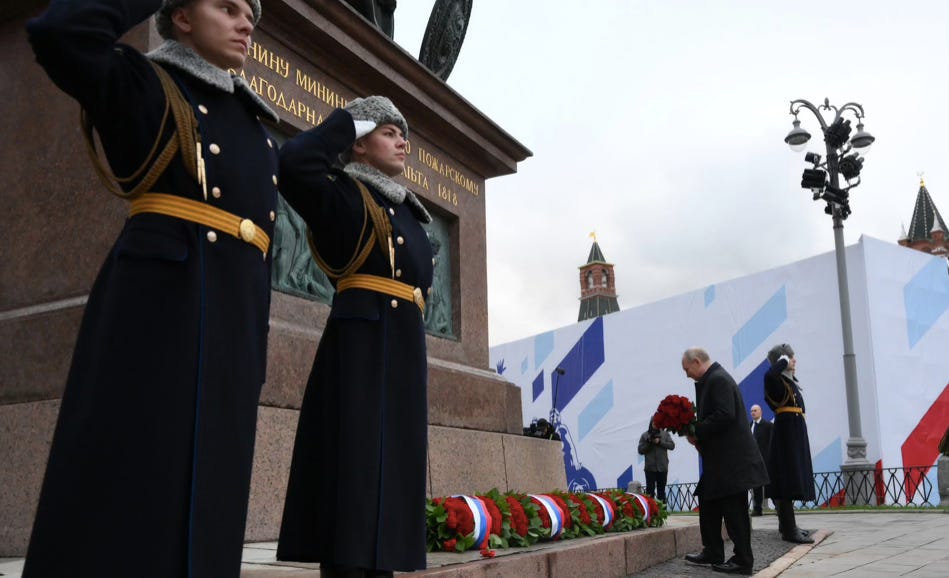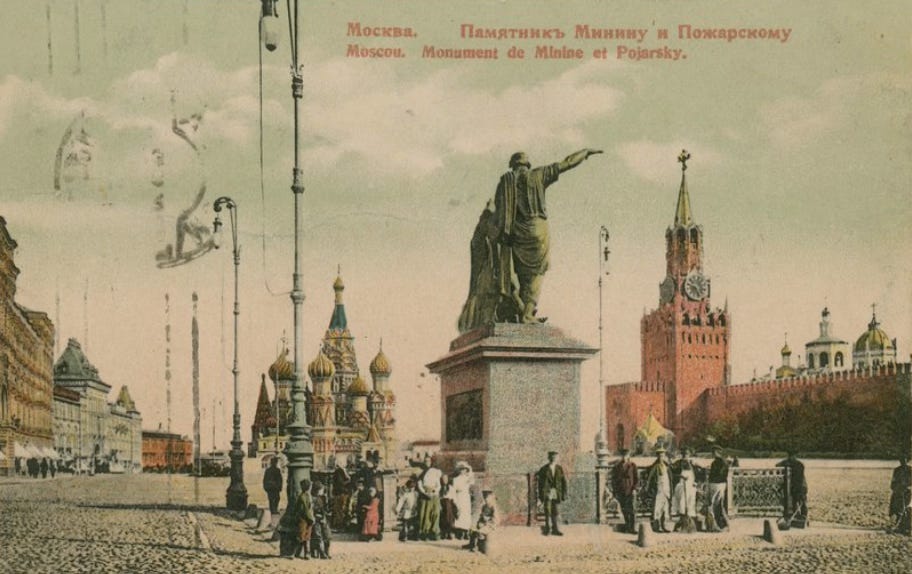Time of Troubles
Moscow doubles down on dark legacies
(‘Putin’ lays flowers at the foot of the Minin and Pozharsky monument on Red Square in Moscow on November 4th, 2025)
Putin came to power promising Russians their problems — the chaos, crime and poverty of the 1990s — were behind them. After a quarter century of dictatorship and war, Russia is poor, isolated and broke. All signs point to new troubles ahead.
Ukraine is striking refineries countrywide. The federal budget deficit is growing as oil and gas revenues shrink. For the Russian army, the front line in Donbas is a meat-grinder swallowing hundreds of lives every day, while barely moving.
The impact of such setbacks is unknown. Dictatorships are notoriously obstinate and inscrutable. In Russia, the most revealing events are often the most routine.
Tuesday was the Day of Popular Unity – a national holiday most Russians do not even mark. It celebrates the defeat and expulsion of a Polish-Lithuanian army in 1612. Its history is as long and tortuous as that of Russian imperialism itself.
When Fyodor I of Russia, third son of Ivan the Terrible, died in 1598, he was the last of the Rurikids, rulers at Vladimir and Moscow in the 1300s who elevated themselves under Ivan in 1547 from grand princes to tsars. For more than a decade, a dynastic struggle played out, pitting Fyodor’s beleaguered successors Boris Godunov and Vasiliy Shuisky against as many as fifteen pretenders to the throne, including three ‘false Dmitrys’ and many self-proclaimed sons of Ivan the Terrible.
It was a national catastrophe. The years from 1598 to 1613 are known in Russia as the Сму́тное время, the ‘time of troubles.’ Millions died. For Russians, the Сму́та was immortalized by Mussorgsky’s opera Boris Godunov. In Polish historiography, the period is known as the Dymitriady, or Polish-Muscovite War of 1609–1618. Poland’s intervention aimed to extend the Commonwealth’s borders by exploiting Moscow’s disarray. It was motivated in part by Sigismund III Vasa’s loss of the crown of Sweden, whose short-lived union with Poland ended in 1599.
By 1610 the ‘seven boyars,’ a faction of Russian nobles, had deposed Shuisky and invited the Polish king’s son to rule Russia. Shuisky was sent to Warsaw in a cage and later murdered in captivity. Tsar Władysław IV Vasa of Poland was elected on September 6th, 1610 but did not take the Russian throne. Instead his father Sigismund III decided to make himself tsar by occupying Russia from 1610 to 1612.
For Tsarist Russia, November 4th marked the defeat of Polish-Lithuanian forces in Kitai-gorod, just outside the walls of the Moscow Kremlin. When the occupying army surrendered the Kremlin itself a few days’ later, the ‘time of troubles’ was over. Influential boyars elected Tsar Mikhail Romanov, founder of a new dynasty.
November 4th was also the feast day of Our Lady of Kazan, a famous icon associated with these events. In 1649, Tsar Alexei I proclaimed the ‘day of the Most Holy Theotokos of Kazan, in memory of the deliverance of Moscow and Russia from the Poles in 1612.’ In 1721, Peter I moved the original icon from Kazan to St. Petersburg. In 1801-11, the Kazan Cathedral was built there to house it.
(A postcard showing the Minin and Pozharsky monument of Red Square in 1913)
In 1803, a clutch of nationalists and philanthropists decided to erect a statue to the two Russian heroes of 1612, a Nizhny Novgorod merchant named Kuzma Minin and a minor Rurikid prince – one of several hundred at the time – named Dmitry Pozharsky. The statue was designed by Ukrainian sculptor Ivan Martos and approved in 1813 by Dowager Queen Maria Fyodorovna, Tsar Paul I’s widow, who had been born in Stettin, today’s Szczecin, Poland.
The Minin and Pozharsky monument was destined for a square in Nizhny Novgorod on the Volga, where Russian forces had first gathered in 1612 before moving on Moscow. But Napoleon’s 1812 invasion and occupation, followed by the burning of Moscow, prompted the sponsors to redirect the statue to Red Square, where it was unveiled as a centrepiece in 1818 and has stood ever since.





